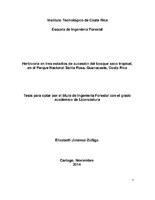"Herbivoría en tres estadios de sucesión del bosque seco tropical, en el Parque Nacional Santa Rosa, Guanacaste, Costa Rica"
Abstract
Due to the positive impact of conservation and accelerated ecological succession in tropical dry forest of Santa Rosa National Park, an outstanding natural restoration of ecosystems is taking place allowing the continuity of the evolutionary far away from human effects. The aim of this study was to characterize the damage to the foliage three successional stages (early, intermediate and late), by herbivorous insects in tropical dry forest of Santa Rosa National Park, Guanacaste, Costa Rica, by evaluation of nine permanent sample plots. The results showed the main patterns of herbivorous insects (chewing, miners and insects that induce galls), in years 2007, 2008 and 2009. In the case of the chewing, most of the damage is in the intermediate stage (6, 05%), followed by the late (5, 58%) and then the early (4, 47%); damage of miners showed no significant differences between stages, but with a notable frequency of mines in the year 2009 (9, 37%). Galls are far more frequent in the early stage (21, 25%), particularly for 2009 when the damage occur more due to higher hydric stressed (water deficit of 688, 7 mm). In the vertical structure of the canopy there were no significant differences, the most obvious pattern was for the late successional stage, where insects prefer the lower incidence of light for feeding, in at the bottom of the treetop.
Description
Proyecto de Graduación (Licenciatura en Ingeniería Forestal). Instituto Tecnológico de Costa Rica, Escuela de Ingeniería Forestal, 2014.


